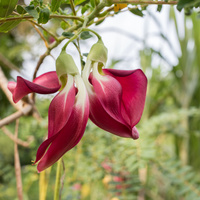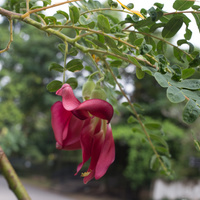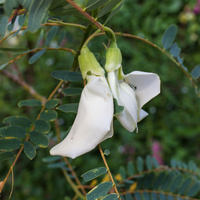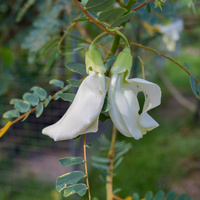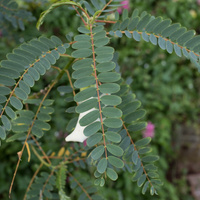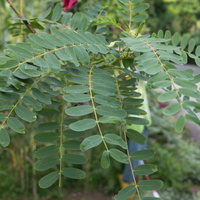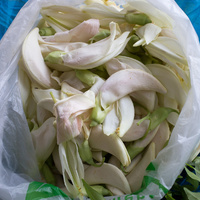Common name: Hummingbird tree
Other common names: Agati, Baby boots, Butterfly tree, Corkwood tree, Scarlet wisteria tree, Swamp pea, Vegetable hummingbird, West Indian pea
Description
Hummingbird Tree is a multiple-purpose tree legume originating in Southeast Asia, its natural range extending across Malaysia, Indonesia, and the Philippines.
It is fast-growing under ideal conditions and may attain heights up to 10 m (32 ft), though it is more commonly 3 to 8 m (10 to 26 ft) tall. The trunk is usually straight, with deeply furrowed grey-brown bark, and supports a crown of wide-spreading branches. However, it is short-lived, having a useful life of only around five years.
Leaves are up to 30 cm (1 ft) long and feathery, consisting of twenty to sixty dull green, oblong leaflets arranged in pairs along the length.
The flowers are large, up to 10 cm (4 in) long and with fleshy white petals, though pink and red-petalled varieties also occur. Blooms are at their heaviest in the winter, with lighter blooms on and off throughout the year. The flowers hang in clusters of two to five and possess a peculiar odour. They are followed by long, thin, stringy seedpods that hang down from the branches. These become brown when mature and then split along their length to release small brown seed.
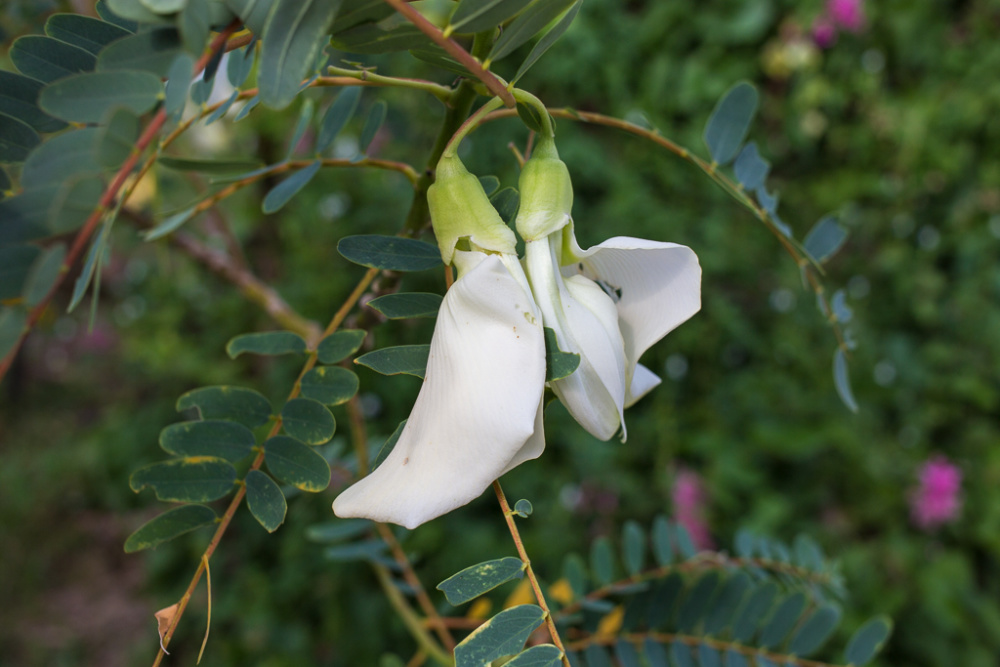
Singapore
Use
White-flowered varieties are cultivated for their unopened flowers, which are edible and eaten either steamed, stir-fried, dipped in batter and fried, made into fritters or added to soups. The flowers of pink- or red-flowered varieties have a bitter taste and are generally not eaten.
Hummingbird Tree produces a soft, white, light-weight wood in the 400 to 500 kilogram per cubic meter (25 to 30 pounds per cubic foot) range. It is occasionally pulped to manufacture paper made for newsprint. Although light-weight and burns quickly without much heat, it is much favoured as firewood in its native range due to the tree's fast growth and its ability to coppice or re-grow after harvesting. When grown for pulp, or firewood, it is spaced around 90 cm (3 ft) apart.
The bark, on wounded, yields an edible gum suitable as a substitute for Gum Arabic (from Senegalia senegal). When freshly exuded, it is either red, or white tinged with red, then on exposure to air hardens to a dark red-violet gum.
The leaves and young seedpods have value as livestock feed, with the leaves becoming available less than six months after sowing. They have a combined crude protein content of around 36% of their dry weight.
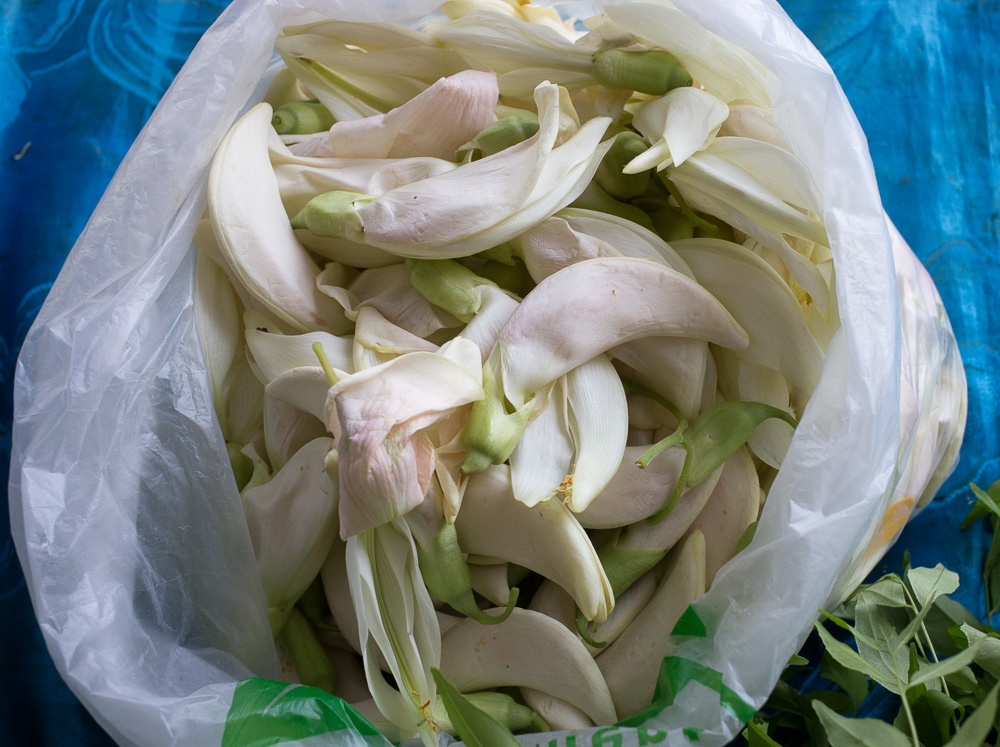
Flowers for sale (Darwin, Australia)
Health use
In traditional medicine, a tea made from the leaves is used as a diuretic and laxative.
Climate
Grows naturally in humid tropical lowland climates, generally in areas with annual lows of 18 to 25°C, annual highs 27 to 35°C, annual rainfall of 900 to 4000 mm and a dry season of 7 months or less, extending to drier arears with irrigation.
Growing
New plants are usually grown from seed, which remain viable for up to a year in storage. Performs best on free-draining, moisture-retaining clay-loam, loam and sandy-loam soils of a moderately acid to slightly alkaline nature, generally with a pH of 5.5 to 7.5, and on sites with full sun exposure. However, it will grow well in almost any well-drained soil due to its nitrogen-fixing ability and good tolerance of seasonal flooding.
Problem features
It seeds freely, with the seed falling from the seedpods to the ground after they split open. There are reports of open thickets occurring in some areas where it grows, but there does not appear to be any records of it as a serious weed. It is assessed as a low weed risk species for Hawaii by the Hawaii Pacific Weed Risk Assessment (HPWRA) project.
Where it grows
References
Books
-
Adams, C. D. 1972, Flowering plants of Jamaica, University of the West Indies, Mona, Greater Kingston
-
Barwick, M., et al. 2004, Tropical & subtropical trees : a worldwide encyclopaedic guide, Thames and Hudson, London
-
Francis, J. K. and Liogier, H. A. 1991, Naturalized exotic tree species in Puerto Rico, General technical report SO-82, USDA Forest Service, Southern Forest Experiment Station, New Orleans
-
Gohl, B. 1981, Tropical Feeds : feed information summaries and nutritive values (Revised edition), Food and Agriculture Organization of the United Nations (FAO), Rome
-
Hocking, D. 1993, Trees for drylands, International Science Publisher, New York
-
Howes, F. N. 1949, Vegetable gums and resins, Chronica Botanica Company, Waltham, Massachusetts
-
Jensen, M. 1999, Trees commonly cultivated in Southeast Asia : an illustrated field guide, 2nd ed., Food and Agricultural Organisation of the United Nations (FAO) Regional Office for Asia and the Pacific (RAP), Bangkok
-
Little, E. L. et al. 1964 and 1974, Common trees of Puerto Rico and the Virgin Islands (2 volumes), Forest Service, U.S. Department of Agriculture (USDA), Washington D.C.
-
Luna, R. K 1996, Plantation trees, International Book Distributors, Dehradun, Uttarakhand
-
Mollison, B. 1993, The permaculture book of ferment and human nutrition, Tagari Publications, Tyalgum, New South Wales
-
Nair, P. K. R. 1993, An introduction to agroforestry, International Centre for Research in Agroforestry (ICRAF), Kluwer Academic Publishers, Dordrecht
-
National Research Council (Board on Science and Technology for International Development) 1979, Tropical legumes : resources for the future, The National Academies Press, Washington D. C.
-
National Research Council (Board on Science and Technology for International Development) 1980, Firewood crops : shrub and tree species for energy production (Volume 1), The National Academies Press, Washington D. C.
-
Parrotta, J. A. 2001, Healing plants of peninsular India, CABI Publishing, Wallingford, Oxfordshire
-
Selvam, V. 2007, Trees and shrubs of the Maldives, Food and Agriculture Organisation (FAO) RAP publication (Maldives), Thammada Press Company Ltd., Bangkok
-
Webb, D. B. 1984, A Guide to species selection for tropical and sub-tropical plantations, 2nd ed., Unit of Tropical Silviculture, Commonwealth Forestry Institute, University of Oxford, Oxfordshire
